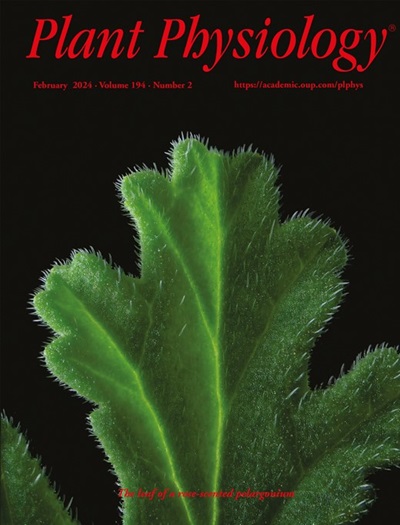三个转录因子组成一个激活-抑制模块来调控亚洲杂交百合花青素的积累
IF 6.5
1区 生物学
Q1 PLANT SCIENCES
引用次数: 0
摘要
亚洲杂交百合花因其鲜艳的颜色和多样的花青素色素而受到消费者的青睐。虽然已经探索了转录因子对花青素积累的调节,但具有乙烯响应元件结合因子相关两亲性抑制(EAR)基序的HD-Zip蛋白通过组蛋白乙酰化调节花青素水平的作用尚不清楚。在这项研究中,我们鉴定了Lhhomeobox-leucine zipper protein 4 (LhHB4)作为HD-Zip II家族的δ组成员,在百合花青素积累中起抑制作用。LhHB4通过结合其启动子直接抑制LhMYBSPLATTER的表达。此外,LhHB4抑制花青素激活因子LhWRKY44的基因表达,进而激活LhMYBSPLATTER的表达,形成一个涉及LhHB4、LhWRKY44和LhMYBSPLATTER的调控模块。此外,LhHB4通过EAR基序与lhtopless相关蛋白(LhTPR3)相互作用,形成抑制复合物。LhTPR3是一种组蛋白去乙酰化酶辅抑制因子。这种相互作用降低了LhWRKY44和LhMYBSPLATTER启动子区域的组蛋白H3乙酰化水平。LhWRKY44和LhMYBSPLATTER基因的下调导致百合花中花青素合成减少。此外,LhHB4和LhMYBSPLATTER建立了一个反馈回路,可以很好地调节花的颜色,LhHB4抑制LhMYBSPLATTER随后促进LhHB4的表达。综上所述,LhHB4、LhWRKY44和LhMYBSPLATTER形成一个激活抑制模块,通过组蛋白乙酰化控制亚洲杂交百合花青素积累。本文章由计算机程序翻译,如有差异,请以英文原文为准。
Three transcription factors form an activation–inhibition module to regulate anthocyanin accumulation in Asiatic hybrid lilies
Asiatic hybrid lilies (Lilium spp.) are favored by consumers for their vibrant colors and diverse anthocyanin pigmentations. Although the regulation of anthocyanin accumulation by transcription factors has been explored, the role of HD-Zip proteins with ethylene-responsive element binding factor associated amphiphilic repression (EAR) motifs in modulating anthocyanin levels through histone acetylation remains unclear. In this study, we identified Lhhomeobox-leucine zipper protein 4 (LhHB4) as a δ group member of the HD-Zip II family, acting as a repressor of anthocyanin accumulation in lilies. LhHB4 directly suppresses the expression of LhMYBSPLATTER by binding to its promoter. In addition, LhHB4 inhibits the gene expression of the anthocyanin activator LhWRKY44, which, in turn, activates LhMYBSPLATTER expression, forming a regulatory module involving LhHB4, LhWRKY44, and LhMYBSPLATTER. Moreover, LhHB4 interacts with the LhTOPLESS-RELATED protein (LhTPR3), a histone deacetylase corepressor, through the EAR motif to form a repressive complex. This interaction reduces histone H3 acetylation levels at the promoter regions of LhWRKY44 and LhMYBSPLATTER. The downregulation of LhWRKY44 and LhMYBSPLATTER results in reduced anthocyanin biosynthesis in lilies. Furthermore, LhHB4 and LhMYBSPLATTER establish a feedback loop that finely regulates flower coloration, with LhMYBSPLATTER inhibition by LhHB4 subsequently promoting LhHB4 expression. In conclusion, LhHB4, LhWRKY44, and LhMYBSPLATTER form an activation–inhibition module that controls anthocyanin accumulation through histone acetylation in Asiatic hybrid lilies.
求助全文
通过发布文献求助,成功后即可免费获取论文全文。
去求助
来源期刊

Plant Physiology
生物-植物科学
CiteScore
12.20
自引率
5.40%
发文量
535
审稿时长
2.3 months
期刊介绍:
Plant Physiology® is a distinguished and highly respected journal with a rich history dating back to its establishment in 1926. It stands as a leading international publication in the field of plant biology, covering a comprehensive range of topics from the molecular and structural aspects of plant life to systems biology and ecophysiology. Recognized as the most highly cited journal in plant sciences, Plant Physiology® is a testament to its commitment to excellence and the dissemination of groundbreaking research.
As the official publication of the American Society of Plant Biologists, Plant Physiology® upholds rigorous peer-review standards, ensuring that the scientific community receives the highest quality research. The journal releases 12 issues annually, providing a steady stream of new findings and insights to its readership.
 求助内容:
求助内容: 应助结果提醒方式:
应助结果提醒方式:


